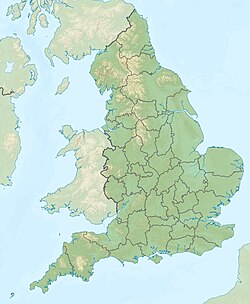| Taxon[1] |
Species |
Presence |
Notes |
Images |
|---|
| Actinopteri[4] |
Indeterminate[4] |
Geographically present in Durdham Down.[4] |
A tooth.[4] |
|
| Agnosphitys[2][5] |
A. cromhallensis[2][5] |
Geographically present in Avon, England (now Bristol).[2] |
Its remains include a left ilium (holotype) and a left maxilla, astragalus and humerus (referred specimen).[2] |
 |
| Agrosaurus[6][2] |
A. macgillivrayi[6][2] |
Geographically present in Avon, England (now Bristol). Originally believed to have been found in Cape York Peninsula, Queensland (Australia).[2] |
A tibia, a claw and some other fragments.[2] |
|
| Archosauria[7] |
Indeterminate[7] |
Geographically present in Durdham Down.[4] |
Five specimens, including jaw fragments, caudals, and a scapulocoracoid.[7] |
|
| Archosauromorpha[4] |
Indeterminate[4] |
Geographically present in Durdham Down.[4] |
A fragment of a small tooth.[4] |
|
| Asylosaurus[2][8] |
A. yalensis[2][8] |
Geographically present in Avon, England (now Bristol).[2][9] |
Dorsal vertebrae, ribs, gastralia, a shoulder girdle, humeri, a partial forearm, and a hand; additional bones from the neck, tail, pelvis, arm and legs that may represent the same individual.[8][2] |
 |
| Chimaeriformes[10] |
Indeterminate[10] |
Geographically present in Bristol.[2] |
Indeterminate remains.[10] |
|
| Clevosaurus[11] |
C. hudsoni[11] |
Geographically present in Gloucestershire.[2] |
Partial cranial and post-cranial skeleton (holotype).[11] |
 |
| Crinoidea[10] |
Indeterminate[10] |
Geographically present in Bristol.[2] |
Reworked from older Carboniferous sediments (Friars Point Limestone Formation).[12] |
|
| Cryptovaranoides[13] |
C. microlanius[13] |
Geographically present in Slickstones Quarry.[13] |
Holotype (partial skeleton) and referred isolated remains.[13] |
 |
| Diphydontosaurus[10] |
D. avonensis[10] |
Geographically present in Bristol.[2] |
Complete to near-complete specimens.[10] |
 |
| Herrerasauria?[8] |
Indeterminate[8] |
Geographically present in Durdham Down.[4] |
3 indeterminate specimens.[8] |
|
| Hwiccewyrm[14] |
H. trispiculum[14] |
Geographically present in Slickstones Quarry.[14] |
Several specimens comprising a partial skeleton.[14] Discovered during the 1970s and listed as cf. Hypsognathus by Whiteside et al. (2016).[15] |
 |
| Hybodontiformes?[4] |
Indeterminate[4] |
Geographically present in Bristol.[2] |
Indeterminate remains.[4] |
|
| Gyrolepis[16] |
Indeterminate[16] |
Geographically present in Bristol.[2] |
Indeterminate remains.[16] |
|
| Kuehneosauridae[4] |
Indeterminate[4] |
Geographically present in Durdham Down.[4] |
Rib that may instead be an ulna belonging to Terrestrisuchus.[4] |
|
| Lissodus[4] |
L. minimus[4] |
Geographically present in Bristol.[2] |
Teeth.[4] |
 |
| Ornithischia[8] |
Indeterminate[8] |
Geographically present in Durdham Down.[4] |
Indeterminate specimen.[8] |
|
| Palaeosaurus[2][8] |
P. cylindrodon[2][8] |
Geographically present in Avon, England (now Bristol) and Bristol.[2] |
Two teeth (one destroyed in 1940).[2] |
 |
| Phytosauria[4] |
Indeterminate[4] |
Geographically present in Durdham Down.[4] |
Two teeth previously assigned to Mystriosuchinae.[4] |
|
| Planocephalosaurus[17][18] |
P. robinsonae[17][18] |
Geographically present in Bristol.[2] |
Skull (holotype) and a tooth.[17] |
|
| Plateosauria[19] |
Indeterminate[19] |
Geographically present in Durdham Down.[4] |
22 partial specimens.[19] |
|
| Rhomphaiodon[4] |
R. minor[4] |
Geographically present in Bristol.[2] |
Teeth, including the subsidiary cusp of one tooth.[4] |
|
| Rileyasuchus[2][20][21] |
R. bristolensis[2][20][21] |
Geographically present in Bristol.[2] |
Two vertebrae and a humerus.[2] |
|
| Sauropodomorpha[8] |
Indeterminate[8] |
Geographically present in Durdham Down.[4] |
Indeterminate remains.[8] |
|
| Sphenosuchia[4] |
Indeterminate[4] |
Geographically present in Durdham Down.[4] |
A right femur initially named as Thecodontosaurus costa.[4] |
|
| Terrestrisuchus[4][10] |
T. gracilis and indeterminate[4][10] |
Geographically present in Bristol and South Wales.[2] |
Indeterminate and partial remains.[4][10] |
 |
| Theropoda[2] |
Indeterminate[2] |
Geographically present in Avon, England (now Bristol) and Bristol.[2] |
A tooth, and a tibia that was once allied with Thecodontosaurus.[2][8] Possibly similar to Pendraig milnerae.[22] |
|
| Thecodontosaurus[2] |
T. antiquus[2] |
Geographically present in Avon, England (now Bristol) and Bristol.[2] |
Partial cranial and postcranial remains (holotype is a lower jaw).[2] |
 |












